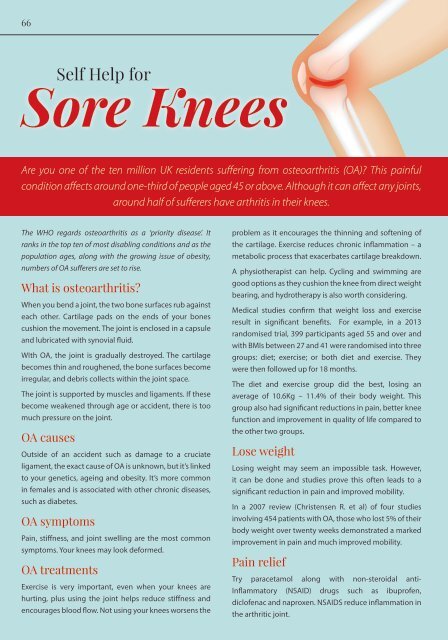You also want an ePaper? Increase the reach of your titles
YUMPU automatically turns print PDFs into web optimized ePapers that Google loves.
66<br />
Self Help for<br />
Sore Knees<br />
Are you one of the ten million UK residents suffering from osteoarthritis (OA)? This painful<br />
condition affects around one-third of people aged 45 or above. Although it can affect any joints,<br />
around half of sufferers have arthritis in their knees.<br />
The WHO regards osteoarthritis as a ‘priority disease’. It<br />
ranks in the top ten of most disabling conditions and as the<br />
population ages, along with the growing issue of obesity,<br />
numbers of OA sufferers are set to rise.<br />
What is osteoarthritis?<br />
When you bend a joint, the two bone surfaces rub against<br />
each other. Cartilage pads on the ends of your bones<br />
cushion the movement. The joint is enclosed in a capsule<br />
and lubricated with synovial fluid.<br />
WIth OA, the joint is gradually destroyed. The cartilage<br />
becomes thin and roughened, the bone surfaces become<br />
irregular, and debris collects within the joint space.<br />
The joint is supported by muscles and ligaments. If these<br />
become weakened through age or accident, there is too<br />
much pressure on the joint.<br />
OA causes<br />
Outside of an accident such as damage to a cruciate<br />
ligament, the exact cause of OA is unknown, but it’s linked<br />
to your genetics, ageing and obesity. It’s more common<br />
in females and is associated with other chronic diseases,<br />
such as diabetes.<br />
OA symptoms<br />
Pain, stiffness, and joint swelling are the most common<br />
symptoms. Your knees may look deformed.<br />
OA treatments<br />
Exercise is very important, even when your knees are<br />
hurting, plus using the joint helps reduce stiffness and<br />
encourages blood flow. Not using your knees worsens the<br />
problem as it encourages the thinning and softening of<br />
the cartilage. Exercise reduces chronic inflammation – a<br />
metabolic process that exacerbates cartilage breakdown.<br />
A physiotherapist can help. Cycling and swimming are<br />
good options as they cushion the knee from direct weight<br />
bearing, and hydrotherapy is also worth considering.<br />
Medical studies confirm that weight loss and exercise<br />
result in significant benefits. For example, in a 2013<br />
randomised trial, 399 participants aged 55 and over and<br />
with BMIs between 27 and 41 were randomised into three<br />
groups: diet; exercise; or both diet and exercise. They<br />
were then followed up for 18 months.<br />
The diet and exercise group did the best, losing an<br />
average of 10.6Kg – 11.4% of their body weight. This<br />
group also had significant reductions in pain, better knee<br />
function and improvement in quality of life compared to<br />
the other two groups.<br />
Lose weight<br />
Losing weight may seem an impossible task. However,<br />
it can be done and studies prove this often leads to a<br />
significant reduction in pain and improved mobility.<br />
In a 2007 review (Christensen R. et al) of four studies<br />
involving 454 patients with OA, those who lost 5% of their<br />
body weight over twenty weeks demonstrated a marked<br />
improvement in pain and much improved mobility.<br />
Pain relief<br />
Try paracetamol along with non-steroidal anti-<br />
Inflammatory (NSAID) drugs such as ibuprofen,<br />
diclofenac and naproxen. NSAIDS reduce inflammation in<br />
the arthritic joint.


















